The Bali map is an indispensable tool for navigating the enchanting island of Bali, renowned for its breathtaking landscapes, rich culture, and warm hospitality. This guide delves into the intricacies of the map, providing a comprehensive overview of Bali’s geography, regions, attractions, and cultural significance.
With its detailed descriptions and insightful analysis, this guide empowers travelers to plan their Bali adventure with confidence, ensuring they uncover the island’s hidden gems and create lasting memories.
Bali Map Overview
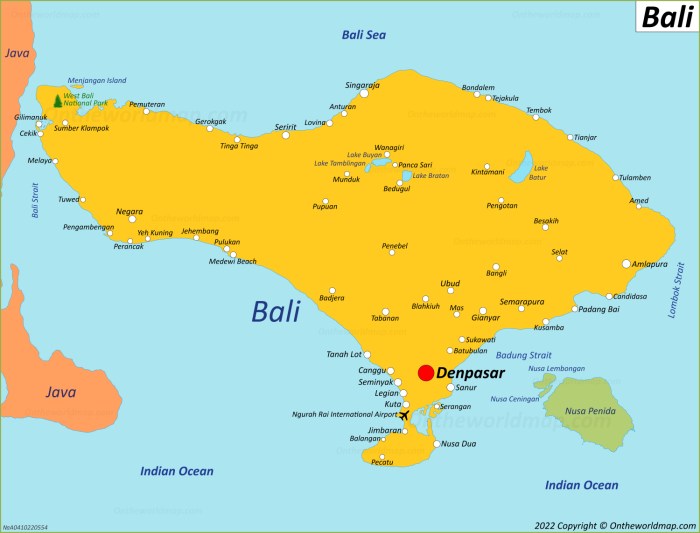
Bali, a captivating Indonesian island, lies in the heart of the Lesser Sunda Islands. Its geographical coordinates, 8°25’18″S 115°14’41″E, position it southeast of Java and west of Lombok, forming part of the archipelago’s westernmost chain.
Bali’s unique shape resembles a diamond, with a total land area of approximately 5,780 square kilometers. The island’s diverse landscapes offer a breathtaking panorama of natural wonders, from towering mountains to pristine beaches and lush rice paddies.
When exploring the diverse island of Bali, a reliable map is essential for navigating its many hidden gems. While exploring Bali’s stunning landscapes, don’t miss the opportunity to venture beyond its shores and discover the vibrant coastal town of aguadilla puerto rico.
Aguadilla boasts crystal-clear waters, pristine beaches, and thrilling water sports. Upon returning to Bali, continue your exploration with an updated map to uncover even more of its enchanting wonders.
Geographical Features
- Mountains: The central highlands of Bali are dominated by an impressive range of volcanic peaks, including Mount Agung, the island’s highest point at 3,031 meters. These volcanic formations have significantly influenced Bali’s topography and contribute to its fertile soil.
- Beaches: Bali boasts an extensive coastline with numerous stunning beaches, each offering a distinct character. From the white sands of Kuta and Seminyak to the secluded coves of Nusa Dua and the surfing paradise of Uluwatu, Bali’s beaches cater to a wide range of preferences.
- Rice Paddies: The verdant rice paddies of Bali are a testament to the island’s agricultural heritage. These meticulously terraced fields, often cascading down hillsides, create a picturesque landscape that has become synonymous with Bali’s rural charm.
Regions and Districts

Bali, an Indonesian province, is geographically divided into eight regions, each boasting distinctive characteristics and attractions. These regions are further subdivided into districts, which offer a diverse range of experiences for travelers.
The following table provides an overview of the main regions and districts of Bali, highlighting their key features and notable landmarks:
| Region | District | Key Features | Notable Landmarks |
|---|---|---|---|
| Badung | Kuta | Beachfront tourism hub, surfing, nightlife | Kuta Beach, Beachwalk Shopping Center |
| Badung | Seminyak | Upscale beach area, luxury resorts, fine dining | Seminyak Beach, Potato Head Beach Club |
| Badung | Jimbaran | Seafood restaurants, sunset views | Jimbaran Bay, Garuda Wisnu Kencana Cultural Park |
| Gianyar | Ubud | Cultural center, rice terraces, art galleries | Ubud Monkey Forest, Tegalalang Rice Terrace |
| Gianyar | Sanur | Beachfront area, relaxed atmosphere, watersports | Sanur Beach, Sindhu Beach |
| Tabanan | Tanah Lot | Iconic sea temple, stunning sunset views | Tanah Lot Temple |
| Tabanan | Bedugul | Mountainous area, lakes, temples | Ulun Danu Bratan Temple, Bedugul Botanical Garden |
| Klungkung | Nusa Penida | Offshore island, pristine beaches, snorkeling | Kelingking Beach, Broken Beach |
Tourist Attractions

Bali offers a myriad of attractions catering to diverse interests, ranging from ancient temples and pristine beaches to captivating cultural experiences. These attractions are scattered across the island, offering something unique in each region.
The following is a categorized list of Bali’s top tourist attractions, highlighting their locations on the map:
Temples
- Pura Tanah Lot (Tabanan): An iconic sea temple perched on a rock formation off the coast, offering stunning sunset views.
- Pura Besakih (Karangasem): Known as the “Mother Temple of Bali,” this sprawling complex is the island’s most important and sacred temple.
- Pura Ulun Danu Bratan (Bedugul): A picturesque temple situated on the shores of Lake Bratan, surrounded by lush greenery and volcanic mountains.
Beaches
- Kuta Beach (Badung): A renowned surfing destination with white sandy beaches, lively nightlife, and numerous shops and restaurants.
- Nusa Dua Beach (Badung): A secluded beach area with crystal-clear waters, perfect for swimming, snorkeling, and sunbathing.
- Jimbaran Bay (Badung): A beautiful beach with calm waters, known for its seafood restaurants serving fresh catches of the day.
Cultural Sites
- Ubud Monkey Forest (Ubud): A sanctuary for hundreds of Balinese long-tailed macaques, offering a glimpse into the island’s unique wildlife.
- Bali Bird Park (Gianyar): Home to over 250 species of birds from around the world, including rare and endangered species.
- Goa Gajah (Gianyar): An ancient cave temple with intricate carvings and a sacred spring, offering a glimpse into Bali’s Hindu-Buddhist heritage.
Transportation and Infrastructure

Bali boasts a comprehensive transportation system that seamlessly connects its regions and facilitates access to its popular tourist destinations. The Ngurah Rai International Airport serves as the primary gateway to the island, with direct flights from major cities worldwide.
For those planning a trip to the Indonesian paradise of Bali, a comprehensive map of the island is essential. It can guide you through the lush landscapes, bustling cities, and hidden gems. While exploring Bali’s natural wonders, consider venturing beyond the island to the Bellagio Conservatory in Las Vegas.
This botanical oasis offers a stunning display of exotic plants and vibrant flowers, providing a unique escape from the tropical paradise of Bali.
The road network in Bali is well-developed, enabling efficient travel between different areas. The main highways connect the southern tourist hubs of Kuta, Seminyak, and Canggu with the cultural center of Ubud and the scenic highlands of Bedugul. Public transportation options are also available, including buses, taxis, and ride-sharing services.
Airport Connectivity
- Ngurah Rai International Airport is located in Tuban, approximately 13 kilometers from Kuta.
- The airport handles both domestic and international flights, with direct connections to major cities in Asia, Australia, and Europe.
- Upon arrival, tourists can easily access various transportation options, including taxis, buses, and ride-sharing services, to reach their desired destinations.
Road Network
- Bali’s road network is extensive and well-maintained, connecting all major tourist destinations.
- The main highways include Jalan Raya Kuta (Kuta Road), Jalan Raya Seminyak (Seminyak Road), and Jalan Raya Ubud (Ubud Road), which provide convenient access to popular beaches, cultural attractions, and scenic landscapes.
- Tourists can rent cars or motorbikes to explore the island at their own pace, enjoying the flexibility and independence of self-guided tours.
Public Transportation
- Bali has a reliable public transportation system that includes buses, taxis, and ride-sharing services.
- Buses are affordable and connect major towns and cities, while taxis are readily available in tourist areas.
- Ride-sharing services, such as Grab and Gojek, offer convenient and cost-effective options for getting around the island.
Cultural Significance
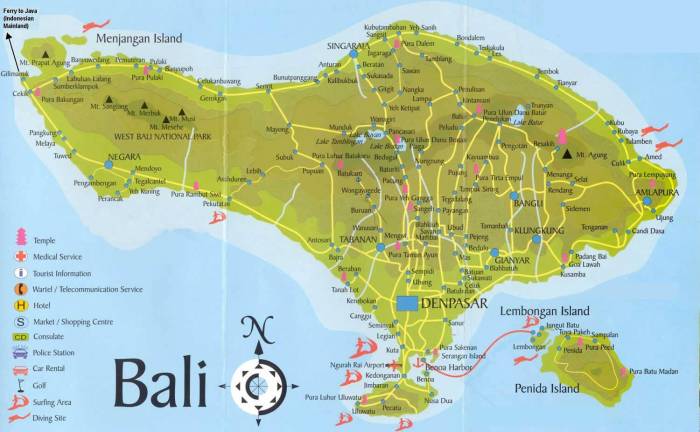
Bali’s map holds profound cultural significance, deeply intertwined with the island’s rich history, spiritual beliefs, and unique way of life. It reflects the island’s sacred geography, where every landmark and natural feature is imbued with religious and cultural meaning.
The map serves as a guide to the island’s sacred sites, temples, and pilgrimage routes. It reveals the harmonious relationship between the Balinese people and their environment, showcasing the island’s intricate irrigation systems, rice paddies, and mountain ranges that shape their daily lives and spiritual practices.
If you’re planning a luxurious getaway, be sure to check out our guide to the top luxury travel destinations. From the breathtaking beaches of Bali to the vibrant streets of Marrakech, there’s something for everyone on our list. And to help you plan your trip, we’ve included a handy map of Bali, so you can easily find your way around this tropical paradise.
Sacred Geography
Bali’s map is a testament to the island’s sacred geography. Mount Agung, the island’s highest peak, is considered the center of the universe and the abode of the gods. The map depicts the flow of holy water from the mountain through rivers and irrigation channels, nourishing the land and purifying the people.
Temples and Pilgrimage, Bali map
The map guides pilgrims along sacred routes to visit the island’s numerous temples. Each temple is dedicated to a specific deity or ancestor and plays a vital role in the Balinese religious calendar. The map reveals the interconnectedness of these temples and their significance in the spiritual life of the people.
Irrigation and Agriculture
The map showcases the intricate irrigation systems that have sustained Bali’s agricultural practices for centuries. The subaks, traditional water cooperatives, manage the flow of water from mountain springs to rice paddies, ensuring a bountiful harvest. The map highlights the importance of water in Balinese culture and the harmonious coexistence between humans and nature.
Economic Impact
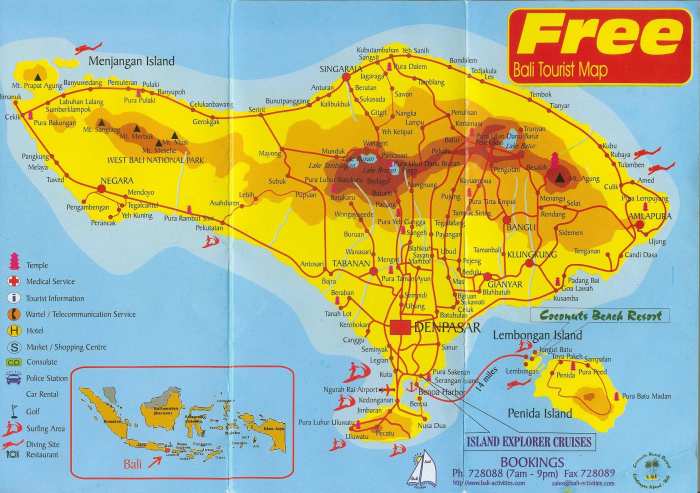
Bali’s tourism industry plays a pivotal role in the island’s economy, generating significant revenue and supporting local businesses. The comprehensive Bali map serves as a valuable tool in attracting visitors and facilitating tourism-related activities.
Tourism revenue in Bali is distributed across various regions and sectors. The southern part of the island, including popular destinations like Kuta, Seminyak, and Jimbaran, accounts for a substantial portion of tourism revenue due to its renowned beaches, luxury resorts, and vibrant nightlife.
Role of the Map in Attracting Visitors
- Visual Representation: The map provides a clear and concise visual representation of Bali’s geography, making it easy for potential visitors to plan their itinerary and explore different regions.
- Destination Discovery: The map highlights key tourist attractions, allowing visitors to discover hidden gems and off-the-beaten-path destinations that may not be well-known.
- Navigation Assistance: The map serves as a reliable navigation tool, helping visitors find their way around the island, locate accommodation, and plan transportation.
Support for Local Businesses
- Increased Visibility: The map showcases local businesses, including hotels, restaurants, and tour operators, increasing their visibility and attracting potential customers.
- Enhanced Accessibility: By providing accurate directions and information, the map makes it easier for visitors to access local businesses, boosting their revenue and supporting the local economy.
- Job Creation: The tourism industry directly and indirectly creates employment opportunities for local residents, contributing to the island’s economic growth and development.
Environmental Considerations
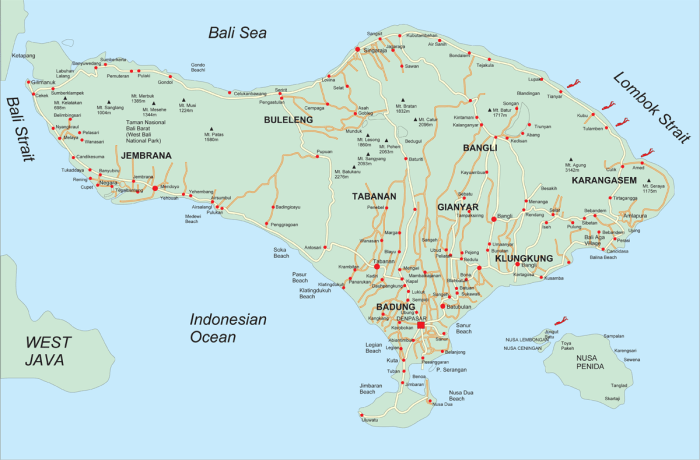
Bali’s tourism industry has significant environmental implications, which the map highlights through its depiction of natural resources. The island’s pristine beaches, lush rainforests, and diverse wildlife are major attractions, but their preservation is crucial for sustainable tourism.
Sustainable Tourism Practices
To protect Bali’s delicate ecosystem, sustainable tourism practices are essential. These include:
- Minimizing waste generation and promoting recycling programs.
- Conserving water resources and using eco-friendly cleaning products.
- Reducing energy consumption through energy-efficient appliances and renewable energy sources.
- Protecting wildlife and their habitats by limiting wildlife interactions and establishing protected areas.
- Educating tourists about responsible tourism practices and the importance of preserving Bali’s environment.
By adopting these practices, Bali can strike a balance between tourism development and environmental conservation, ensuring the island’s natural beauty and biodiversity for future generations.
Future Developments
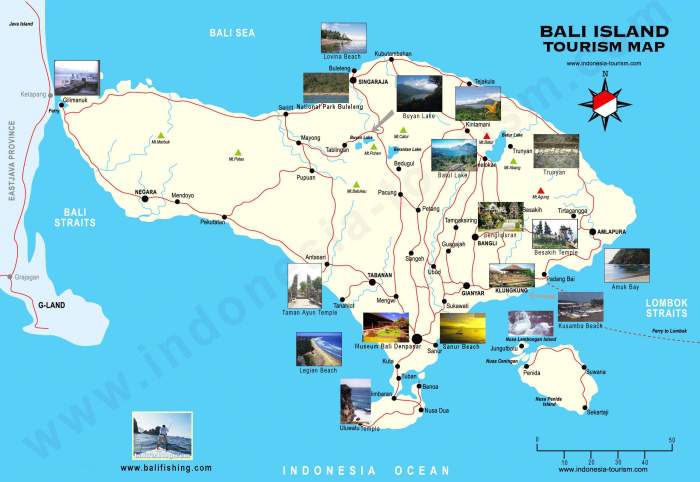
Bali’s map is poised for significant developments in the coming years, driven by technological advancements and evolving tourism trends. These developments have the potential to reshape the island’s economy, culture, and environment.
One key area of development is the integration of technology into the map. Augmented reality (AR) and virtual reality (VR) applications could enhance the visitor experience, providing immersive and interactive ways to explore the island’s attractions. Digital mapping tools could also improve navigation and accessibility, making it easier for tourists to discover hidden gems and navigate unfamiliar areas.
Tourism Trends
Bali’s tourism industry is constantly evolving, and the map is expected to adapt to meet the changing needs of travelers. Sustainable tourism practices are becoming increasingly important, and the map could incorporate information on eco-friendly accommodations, transportation options, and attractions.
Another trend is the rise of experiential tourism. Visitors are seeking unique and immersive experiences that connect them with the local culture and environment. The map could highlight opportunities for cultural immersion, such as traditional ceremonies, cooking classes, and guided tours of historical sites.
These developments are likely to have significant implications for Bali’s economy. Increased tourism could lead to job creation and economic growth. However, it is crucial to manage development sustainably to minimize the negative impacts on the island’s environment and culture.
Last Recap: Bali Map

In conclusion, the Bali map is more than just a navigational aid; it is a gateway to a world of wonder and enchantment. By understanding the map’s intricacies, travelers can unlock the true essence of Bali, embracing its diverse landscapes, vibrant culture, and timeless traditions.
As the island continues to evolve, so too will its map, reflecting the ever-changing tapestry of Bali’s natural beauty, cultural heritage, and economic development. Future developments promise to enhance the visitor experience, making Bali an even more captivating destination for years to come.
FAQ Compilation
What is the best way to use the Bali map?
The Bali map can be used online or downloaded for offline use. It is recommended to zoom in and out to explore different areas of the island and use the search function to find specific locations.
What are the key features of the Bali map?
The Bali map includes detailed information on roads, landmarks, attractions, and other points of interest. It also provides elevation data, making it easy to plan hikes and other outdoor activities.
How often is the Bali map updated?
The Bali map is updated regularly to reflect changes in the island’s infrastructure and attractions. It is recommended to check for updates before each trip.